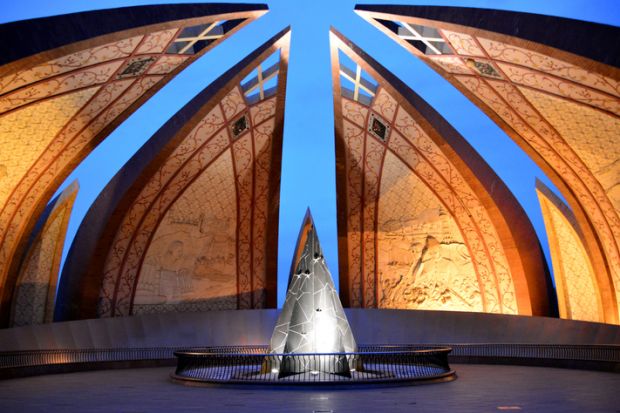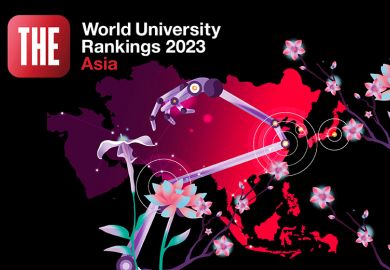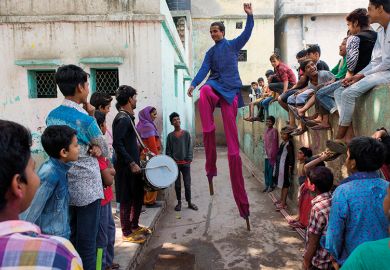Browse the full Asia University Rankings 2023 results
The number of South Asian universities in the top 200 of Times Higher Education’s Asia University Rankings has climbed to a five-year high, this year’s figures show.
There are 32 universities from Pakistan, India, Bangladesh, and Sri Lanka in the top 200 this year – a marked rise from 24 universities in 2022 and higher than pre-pandemic levels in 2019, when 25 institutions from South Asia made the cut.
Pakistan leads the charge, with 10 universities in the top 200 this year, up from six last year.
Among them, the highest ranking institution is Quaid-i-Azam University, which rose from 116th to 98th place. Originally known as Islamabad University, it started as a postgraduate institution with a research focus but has expanded to teaching and undergraduate studies. Its overall score improved from 41.9 last year to 46.0 this year.
Dynamic traffic: Asia’s changing internationalisation hotspots
Asia University Rankings 2023: an ever richer dataset
Asia University Rankings 2023: work that's worth noting
Rocky Tuan: Hong Kong sits ‘enviably’ between China and the world
Lily Kong on not trying to be Harvard or Oxford
Saeeda Shah, a Pakistan-born academic and former professor of education at the University of Leicester, said the country’s improvement can be traced back to policies under Atta-ur-Rahman, an education minister in the early 2000s who prioritised doctoral research.
“On the one hand, they made it a requirement that people should have a PhD when they joined the university staff…those who were already university teachers were supported to get research degrees,” she said.
Informal contributions, especially by women, have also helped develop mentorships, networks and on-the-ground research – other key ingredients for improving quality, Dr Shah said.
This year’s top 200 list also includes two institutions from Bangladesh for the first time: the University of Dhaka, which moves up from the 251-300 band to 186th place; and North South University, which was not ranked last year and is now 192nd.
India, which has traditionally been a larger contributor to the top 200 ranks than its neighbours, had only a slight boost in representation in this year’s league tables, with 18 universities – one more than last year. Meanwhile, its highest-ranking university, the Indian Institute of Science, slipped to 48th place – its lowest rank since 2015, when it first entered the ranking.
THE Asia University Rankings 2023: the top 10
| 2023 rank | Institution | Country/region | Overall score |
| 1 | Tsinghua University | China | 88.2 |
| 2 | Peking University | China | 87.8 |
| 3 | National University of Singapore | Singapore | 87.2 |
| 4 | University of Hong Kong | Hong Kong | 80.1 |
| 5 | Nanyang Technological University, Singapore | Singapore | 79.2 |
| 6 | Chinese University of Hong Kong | Hong Kong | 76.1 |
| 7 | The Hong Kong University of Science and Technology | Hong Kong | 75.3 |
| 8 | The University of Tokyo | Japan | 75.0 |
| =9 | Fudan University | China | 73.4 |
| =9 | Shanghai Jiao Tong University | China | 73.4 |
Further north, Iran improved significantly in this year’s rankings, with 65 universities in the 2023 rankings, up from 58 last year, and nine institutions in the top 100 – three more than last year.
Its rise comes amid continued upheaval in the country following the death of Mahsa Amini, who died last September while in custody for wearing her hijab “improperly”. University students have been at the forefront of nationwide protests, with thousands of them arrested for participating, while academics were laid off for expressing solidarity.
Arshin Adib-Moghaddam, professor of global thought and comparative philosophies at SOAS University of London, said the anti-government demonstrations were “a direct effect of a highly educated society outgrowing a conservative state”.
Since the 1979 Iranian Revolution, its government has overseen a “vast expansion” of the higher education sector. Over the past few decades, a “massive” rise in student numbers has created increased capacity for global research, particularly in the hard sciences – resulting in “impressive” growth in domestic capacity despite sanctions, he said.
China is building a ‘community of learning for mankind’ online
Can India achieve its ambitions for higher education?
Asia must do more to cultivate good university leaders
‘Academic integrity is improving, but Asia needs transparency culture’
Asia University Rankings 2023 digital edition
Between 2017 and 2021 there was a 46 per cent increase in Iran’s research, as measured by publications. By 2021, its output in life sciences surged 75 per cent above 2017 levels; for clinical and health research, that figure rose 68 per cent.
But these gains come amid a bleaker picture for the sector, which faces wider crackdown by the ruling regime, said Professor Adib-Moghaddam.
“What is needed to dwarf such efforts [to crack down on universities], is more international cooperation with Iranian universities and academics,” he said.
THE’s Asia University Rankings uses the same 13 performance indicators as the World University Rankings, but they are recalibrated to reflect the attributes of Asia’s institutions.
Register to continue
Why register?
- Registration is free and only takes a moment
- Once registered, you can read 3 articles a month
- Sign up for our newsletter
Subscribe
Or subscribe for unlimited access to:
- Unlimited access to news, views, insights & reviews
- Digital editions
- Digital access to THE’s university and college rankings analysis
Already registered or a current subscriber? Login








